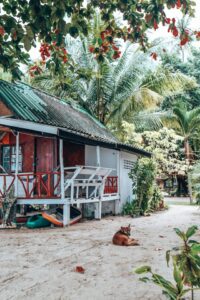Nestled within the lush rainforests of Belize, a winged marvel captures the imagination of all who encounter it—the Blue Morpho Butterfly. With wings that seem to capture the very essence of the sky’s cerulean hues, this enchanting creature is not just a spectacle but a vital part of Belize’s rich biodiversity. In this article, we delve into the captivating world of the Blue Morpho, exploring its mesmerizing beauty, its habitat and behavior within Belize’s rainforests, and the challenges faced in safeguarding its existence for generations to come.
Unveiling the Beauty: Exploring the Iridescent Blue Wings of Belize’s Blue Morpho
The iridescent blue wings of the Blue Morpho Butterfly are a sight to behold, captivating observers with their ethereal beauty and shimmering brilliance. These wings, spanning up to six inches in width, are a masterpiece of nature’s artistry, reflecting and refracting light in a mesmerizing dance of color.
What makes the Blue Morpho’s wings particularly fascinating is their unique structure. Unlike most butterflies whose wing coloration comes from pigments, the Blue Morpho’s iridescence is a result of microscopic scales on its wings that act like prisms. These scales are arranged in such a way that they refract light, creating the stunning blue hues that seem to change with every angle and light condition. This adaptation not only serves as a visual spectacle but also plays a role in the butterfly’s survival.
In the dappled sunlight of Belize’s rainforests, where the Blue Morpho makes its home, these iridescent wings serve multiple purposes. They play a role in communication, with males using their shimmering wings to attract females during courtship displays. The dazzling display of blues not only signals genetic fitness but also acts as a form of camouflage, helping the butterfly blend into the shifting light patterns of the forest canopy.
Beyond their aesthetic allure, the Blue Morpho’s wings also have a practical function. They serve as a defense mechanism against predators. When threatened, the butterfly can suddenly flash its wings open, revealing a burst of bright blue that startles or confuses predators, allowing the butterfly to escape to safety.
The iridescent blue wings of the Blue Morpho Butterfly are not just a marvel of nature; they are a testament to the intricate and adaptive design of life in Belize’s rainforests. As we continue to unravel the mysteries of these stunning creatures, we gain a deeper appreciation for the delicate balance of ecosystems and the importance of preserving the natural wonders that grace our planet.
Life in Belize’s Rainforest: Habitat and Behavior of the Blue Morpho
The Blue Morpho Butterfly’s exquisite wings are not the only aspects that make it a fascinating creature; its habitat and behavior within Belize’s rainforests add layers of intrigue to its story. Found primarily in the tropical forests of Central and South America, including Belize, the Blue Morpho thrives in the diverse and vibrant ecosystems of these regions.
Belize’s rainforests provide the ideal environment for the Blue Morpho to flourish. With their dense canopy, abundant plant life, and humid climate, these forests offer a haven for butterflies like the Blue Morpho. The butterfly’s life cycle begins as an egg laid on the underside of a leaf. Upon hatching, the caterpillar feeds voraciously on leaves, growing rapidly before transforming into a pupa, also known as a chrysalis. Within this protective casing, the miraculous process of metamorphosis occurs, culminating in the emergence of the adult butterfly with its iconic blue wings.
One of the most intriguing aspects of the Blue Morpho’s behavior is its role in the rainforest’s ecosystem. As adults, these butterflies primarily feed on rotting fruits, tree sap, and nectar from flowers. In doing so, they play a crucial role in pollination, aiding in the reproduction of countless plant species within their habitat. This mutualistic relationship highlights the interconnectedness of species in Belize’s rainforests, where each organism contributes to the overall health and biodiversity of the ecosystem.
Furthermore, the Blue Morpho’s behavior is shaped by its interactions with other species. From evading predators like birds and bats to engaging in courtship rituals with potential mates, these butterflies navigate a complex web of relationships within their forest home. Their ability to adapt and thrive in this dynamic environment is a testament to the resilience of nature and the intricate balance of life in Belize’s rainforests.
Understanding the habitat and behavior of the Blue Morpho not only sheds light on the intricacies of its existence but also underscores the importance of preserving Belize’s precious rainforest ecosystems for future generations to cherish and study.
Conservation Challenges: Protecting Belize’s Blue Morpho Population
While the Blue Morpho Butterfly enchants with its beauty and plays a vital role in Belize’s rainforest ecosystems, it also faces significant conservation challenges that threaten its population. The delicate balance of nature in Belize’s rainforests is increasingly under pressure due to human activities, climate change, and habitat loss, posing a threat to the survival of species like the Blue Morpho.
One of the primary challenges facing the Blue Morpho Butterfly is habitat destruction. Deforestation, often driven by agricultural expansion and logging, leads to the loss of crucial forested areas where these butterflies live and breed. As their habitat diminishes, so does their ability to find suitable food sources, breeding sites, and shelter, putting stress on their populations.
Additionally, the fragmentation of forests further exacerbates the plight of the Blue Morpho. Disconnected patches of forest limit the butterfly’s ability to move between suitable habitats, leading to isolated populations that are more vulnerable to genetic issues and local extinction. This fragmentation also disrupts the natural pollination and ecological processes that rely on the seamless connectivity of forest ecosystems.
Climate change poses another significant threat to the Blue Morpho Butterfly and other species in Belize. Shifts in temperature and precipitation patterns can disrupt the delicate balance of the rainforest environment, affecting plant growth, insect life cycles, and overall ecosystem dynamics. These changes can directly impact the availability of food and suitable habitat for the Blue Morpho, further endangering its survival.
Conservation efforts aimed at protecting the Blue Morpho Butterfly and its habitat are crucial for ensuring the long-term survival of this iconic species. These efforts may include establishing protected areas, promoting sustainable land use practices, reforestation initiatives, and raising awareness about the importance of biodiversity conservation among local communities and policymakers. By addressing the conservation challenges faced by the Blue Morpho, we can contribute to safeguarding Belize’s natural heritage and preserving the intricate web of life in its rainforests.
Final Thoughts:
The Blue Morpho Butterfly stands as a symbol of the intricate beauty and delicate balance of Belize’s rainforests. Its iridescent blue wings, habitat preferences, and ecological interactions paint a vivid picture of the interconnectedness of life in these biodiverse ecosystems. However, amidst its captivating allure, the Blue Morpho also faces daunting conservation challenges that threaten its existence.
As we reflect on the habitat destruction, fragmentation, climate change impacts, and other threats looming over the Blue Morpho, it becomes clear that concerted conservation efforts are imperative. Preserving Belize’s rainforests is not just about protecting a single species but about safeguarding entire ecosystems and the myriad of plants, animals, and ecological processes they support.
Conservation strategies must encompass a holistic approach that addresses both the direct threats to the Blue Morpho and the underlying drivers of habitat loss and degradation. This includes advocating for sustainable land use practices, establishing and maintaining protected areas, restoring degraded habitats, and fostering community engagement and education on biodiversity conservation.
Furthermore, the conservation of the Blue Morpho Butterfly is not an isolated endeavor but part of a global conservation movement aimed at protecting Earth’s natural heritage. By valuing and protecting species like the Blue Morpho, we not only ensure their survival but also contribute to the resilience and health of our planet’s ecosystems.
In closing, the enchanting beauty of the Blue Morpho serves as a reminder of the wonders of nature and the responsibility we bear in preserving them for future generations. Through collaboration, innovation, and dedication to conservation, we can aspire to a future where the Blue Morpho continues to grace Belize’s rainforests, inspiring awe and admiration for generations to come.




